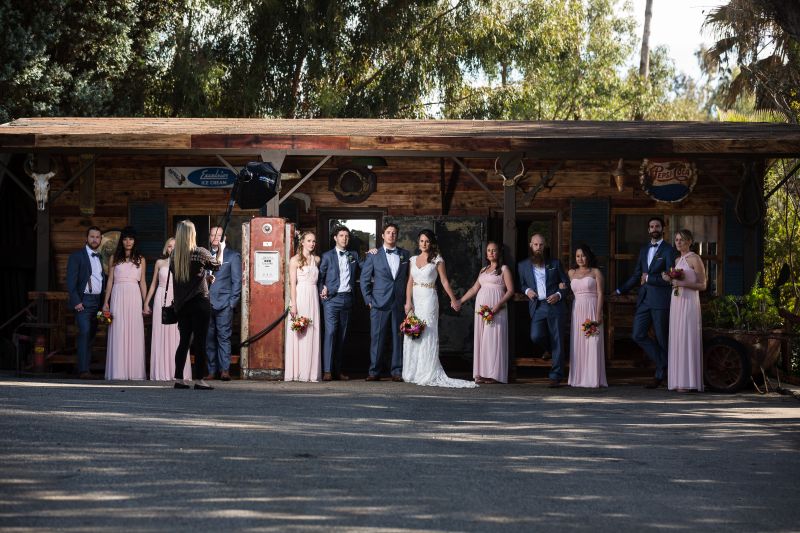Flash modifiers in photography are used to alter the quality, color, shape, or direction of light. The right modifier depends on your creative vision and intended use. In this article, we’ll provide you with an overview of the different flash modifiers available so that you can determine which is right for your particular photographic style.
Flash Gels

Flash gels are an easy and affordable way to get started with light shaping and color balance with your flash. Gels are a good way to get your flash to match the ambient light, or to get some neat creative effects!
PROS: Ideal for shooting creative flash photography and an easy trick to transform a scene.
CONS: Must understand how each color affects each scene’s ambient light exposure in combination with your in-camera white balance. Sometimes, it can come off as cheesy or
USES: Creatively alter the look of your scene or correct skin tones to match the ambient light. Learn how to visually change your camera’s white balance here.
Reflectors
When shooting outdoors, reflectors are extremely powerful tools, and when used correctly they can be used as the main light, fill light, rim light, etc. You can bounce a flash off of the reflector or simple angle it to catch sunlight and push that light towards the subject.
PROS: One of the cheapest, fastest ways to create and control soft light sources. Bouncing flash off a wall or ceiling is also very effective and simple. It’s also very portable compared to lugging around a softbox or light stands.
CONS: Reflectors can waste light power, (brightness) and your non-reflector bounce options are extremely limited if a ceiling is high, or any off-white color. It can be difficult to create consistent exposures, especially if an assistant is hand-holding a reflector and you’re bouncing flash from on-camera. You also risk losing a lot of light power since there isn’t much control from your on-camera flash.
USES: Active or fast-paced situations such as on-location sessions or lifestyle portrait shoots, where you want to create soft diffused light but need to be moving around a lot. Reflectors are more practical for sunlight, while on-camera flash-bouncing is more practical for indoor walls and ceilings. Here is a great example video that shows how you can use a simple on-camera flash and the white side of the reflector to create a portable softbox.
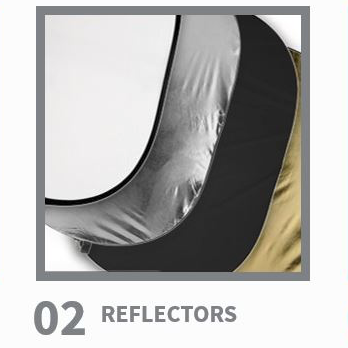
- Westcott 40″ 5 in 1 ($40)
- Westcott Omega 10 in 1 ($100)
- Fotodiox 40×60 5 in 1 ($40)

Beauty Dishes
DESCRIPTION: Uses off-camera flash or strobes to create soft, beauty portraiture light. You can watch the full video on how we created the shot above here!
PROS: Very soft yet highly controllable quality of light, thanks to specific grid accessories.
CONS: Many do not collapse, require a lot of flash power, and can become rather expensive when buying a complete system.
USES: Anything from general portraiture to high-end fashion work, as long as you have the help (assistant) to manage it, and the time for setup and break-down. Very good at keeping light focused on the subject and off of the foreground/background, allowing you to shoot a very complex scene with ease.
- Profoto OCF 24″ Beauty Dish with Deflector Plate
- Profoto OCF Magnum Reflector
- Glow 22″ White Beauty Dish for Bowens Mount
Bounce/Mini Beauty
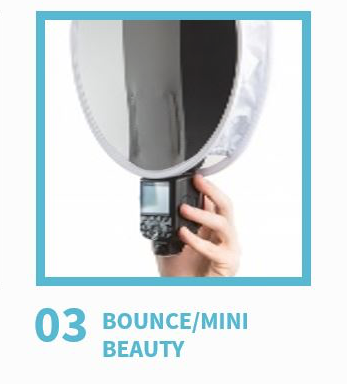
- Favorite: Fstoppers Flash Disc ($50)
- Budget: Impact Strobros ($29)
A bounce/mini beauty will give your tight portraits an editorial glamor look. Direct flash isn’t commonly used, but that doesn’t mean it can’t look good. When these modifiers are used correctly, it can turn an ordinary portrait into an extraordinary one.

Flash Snoots and Grids
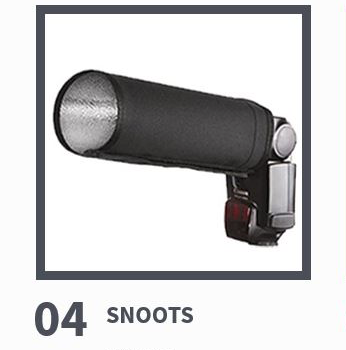
- XP Portaflex ($10)
A snoot is a tool that can pin light your subject from your flash. It differs from the grid because it can focus the light into a smaller beam and you don’t lose as much light with this modifier.
PROS: Pin-point light-shaping abilities, similar to spotlight effect.
CONS: Some grids either cut too much light or not enough depending on the necessary modification. Usually, lower quality grids tend to have more light spill or less gradual light fall-off which defeats the purpose of using a grid.
USES: Small accents (hair, rim lighting, etc.) Also good for wide-angle shots that need a spotlight on a subject within a scene, anything from an environmental portrait to an ultra-wide angle first dance shot.
Ring Flash
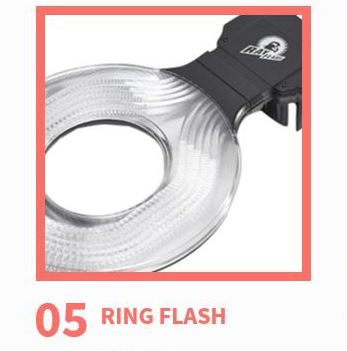
- Favorite: Expolmaging Ray Flash 2 ($140)
- Budget: DIYP Ring Flash Kit($25)
This is another modifier used to give tight portraits that beautiful soft fashion look. This modifier is unique because it surrounds the lens, providing even lighting for your subject.
Dome or Sphere
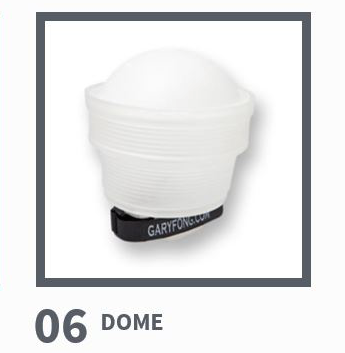
- Favorite: Magmod Magsphere
- Alternate: Gary Fong ($60)
- Budget: EzFoto Dome ($29)
The dome is the ultimate event photography modifier. It’s an ingenious little modifier that combines bounce and direct flash. That means it’s providing ambient overhead light while also filling in light on your subject’s faces.
PROS: Quick, simple soft or diffused light, highly portable, efficient.
CONS: Not soft enough or not softer than an umbrella. Some options still have some specularity. Each one of the options below does different things so please be aware of that prior to purchasing.
USES: When you wanted to soften or diffuse the light on your subject instead of pointing a bare bulb towards them. If you are working an event or wedding, having a softer or more diffused on-camera light source will yield better results.
- MagMod MagSphere
- Gary Fong Lightsphere
- Fstoppers Flash Disc Portable Speedlight Softbox
- MagMod MagBounce
Photography Umbrellas

Let’s start with the umbrella. These are used to soften the light from an off camera flash. They are cheap, highly portable, and easy to set up. The downside is that the light from an umbrella spills everywhere in the scene. So if you need more directional control, you’ll likely want to opt for a softbox, which we discuss below.
PROS: Creates a soft and large light source that you can take with you no matter where you go.
CONS: Can be a little obtrusive because of the size. It has a wide spread because there is no cover for the umbrella, making it hard to control the light spill. Can create shadows on the wall that distinctly giveaway the type of light source used.
USES: Simple lighting setups where you need to quickly set up 1-2 lights, get a light source that is bigger than a bare strobe, yet still bright. Great for photographing large groups and soft portraits.
Favorite & Budget: Impact Umbrella – White Translucent (33″)
Softboxes

A softbox is similar to an umbrella in that it softens and diffuses the light coming from the off camera flash. The primary difference is that the tent-like shape provides more control over the direction of the flash. You can even add a grid to the softbox to really pinpoint the direction of the light. The primary drawback is that the softbox is larger and takes longer to set up. For this reason, many wedding and event photographers stick to umbrellas.
PROS: Great balance of portability and light control, doesn’t spill everywhere, much easier to get huge directional light sources especially if you have a grid. Many options are very affordable and fast to set up. (umbrella boxes)
CONS: Some options can be pricey, some aren’t exactly effortless to set up.
USES: The better your lighting is, the less post-production you’ll have to do, and the more clean and polished your images will look. A softbox is great for shooting a single subject, a couple, or an entire family, either in-studio or on-location. Add a flash grid to the softbox, if you’re in a setting where you want to minimize spill on foreground/background.
Favorite: MagMod MagBox Pro 42″ Octa Softbox
Budget: Aputure Lantern Softbox (2.2′)
Conclusion
As with anything in photography, make your purchasing decisions based on your intended use. For example, a wedding photographer with 12 hour shooting days may opt for the most portable options while a studio photographer might be better suited for larger softboxes. Also, keep things simple and realize that bigger and more expensive is not always better. Oftentimes the best light is simply natural light. For more information on flash photography, be sure to see our Flash Training System inside the SLR Lounge Premium.


